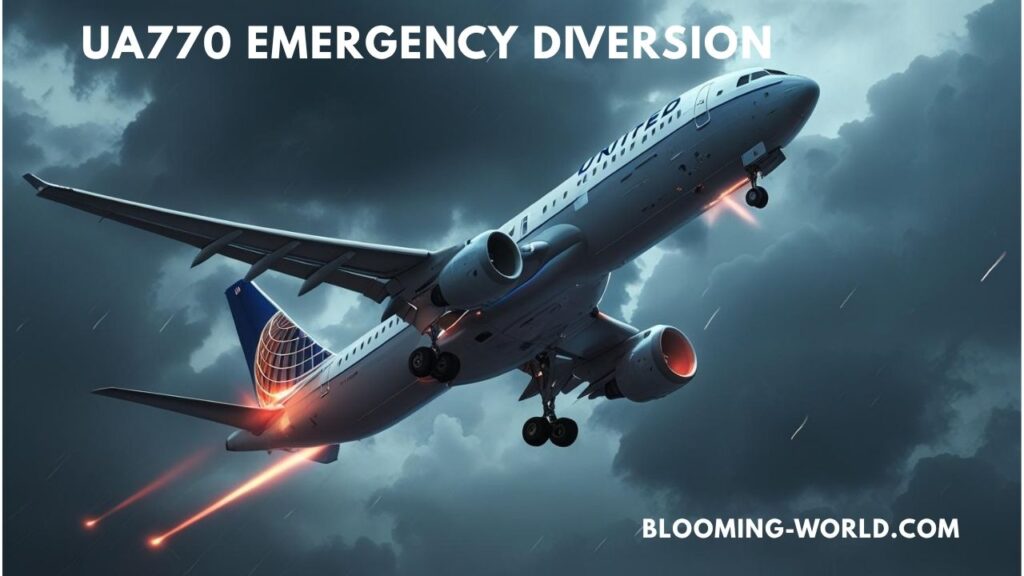- A Routine Flight Turned Unexpected
- What Triggered the United Airlines Flight UA770 Emergency Diversion?
- Inside the Cabin: Passenger Experience During the Emergency Diversion
- How Emergency Diversions Work: A Look Behind the Scenes
- Post-Landing: What United Airlines Did Next
- The Role of Social Media in the Emergency Diversion
- What the Industry Can Learn from United Airlines Flight UA770 Emergency Diversion
- Final Thoughts: A Flight That Proved Safety First Works
- FAQs: United Airlines Flight UA770 Emergency Diversion
A Routine Flight Turned Unexpected
The United Airlines Flight UA770 emergency diversion wasn’t just another flight delay—it was a real-time example of aviation safety systems working precisely as they should.
On Friday, 25-Jul-2025 04:17 PM CEST Barcelona Int’l – BCN. 06:50 PM CDT, United Airlines Flight UA770 departed from Barcelona-El Prat Airport heading for Chicago O’Hare International Airport. With 78 passengers and nine crew members onboard, the flight took off under clear skies. Everything seemed normal until a technical alert appeared mid-flight at 7700.
Though not immediately dangerous, the issue triggered a chain of decisions that would soon lead to the United Airlines Flight UA770 emergency diversion. This precautionary move reflected the airline’s deep commitment to safety.
What Triggered the United Airlines Flight UA770 Emergency Diversion?
The In-Flight Technical Alert
Shortly after reaching cruising altitude, an alert was received in the cockpit. While not a cause for alarm on its own, such alerts require strict attention. Pilots ran through diagnostics and coordinated with ground teams to verify the issue.
When the systems flagged a potential risk, the pilots took no chances. The decision to begin the United Airlines Flight UA770 emergency diversion came swiftly, following aviation best practices.
Choosing London Heathrow Airport
The crew quickly evaluated nearby airports and determined that London Heathrow Airport was the safest choice. Factors such as:
- Runway length
- Emergency readiness
- Weather conditions
- Aircraft proximity
All played into the decision. It was the perfect fit for executing the United Airlines Flight UA770 emergency diversion quickly and safely.
Inside the Cabin: Passenger Experience During the Emergency Diversion
Calm in the Face of Uncertainty
When passengers heard the announcement about the United Airlines Flight UA770 emergency diversion, a wave of concern naturally spread through the cabin; however, the pilot’s calm and direct tone helped ease nerves.
Flight attendants played a vital role too. They moved through the cabin, securing items, checking seatbelts, and speaking to concerned passengers one-on-one. Their professionalism helped maintain calm throughout the cabin.
One passenger later shared, “Even though we were being diverted, the crew made it feel like we were always in control.”
How Emergency Diversions Work: A Look Behind the Scenes
ATC and Airline Coordination
Once the United Airlines Flight UA770 emergency diversion was declared, air traffic control (ATC) cleared nearby airspace and gave the flight top priority.
United Airlines’ operations center stayed in contact with the pilots throughout the descent, providing weather updates and ensuring that emergency services were on standby at London Heathrow Airport.
Emergency Teams on the Ground
As the plane approached London Heathrow Airport, fire trucks and medical teams waited along the runway—a standard protocol during any declared emergency.
Fortunately, the United Airlines Flight UA770 emergency diversion ended with a smooth, safe landing. No one was hurt, and the aircraft taxied safely to a remote stand for inspection.
Post-Landing: What United Airlines Did Next
Taking Care of Passengers
After the aircraft landed, passengers remained onboard briefly as emergency teams inspected the exterior. Once cleared, passengers deplaned calmly and were met by United staff.
United Airlines activated its emergency response protocol immediately following the United Airlines Flight UA770 emergency diversion, which included:
- Rebooking flights
- Providing hotel accommodations
- Offering meal vouchers
- Giving real-time travel assistance
United’s customer support response showed empathy, precision, and accountability.
Aircraft Inspection and Maintenance
Following the United Airlines Flight UA770 emergency diversion, maintenance teams at London Heathrow Airport thoroughly examined the aircraft. The cause of the technical alert was identified and resolved before the plane was cleared to return to service.
Every safety protocol was followed, ensuring full FAA compliance before resuming operations.
The Role of Social Media in the Emergency Diversion
Sharing the Experience Online
As news of the United Airlines Flight UA770 emergency diversion spread, passengers took to platforms like Twitter and Instagram to share their experiences. Many praised the crew for their professionalism and calm demeanor.
The hashtag #UA770 trended briefly, with travelers, aviation enthusiasts, and safety experts chiming in with support.
United’s Official Statement
Later in the day, United Airlines issued an official press release confirming the emergency diversion and emphasizing the airline’s commitment to safety. The release also praised the crew and ground support teams for their quick thinking and flawless execution.
From Tension to Togetherness: Stories from the Cabin
The United Airlines Flight UA770 emergency diversion wasn’t just about technical systems and protocols—it was also about people.
While waiting in the terminal, passengers bonded. They shared phone chargers, snacks, and stories. For many, it turned a stressful event into a moment of unexpected connection.
As one traveler put it:
“We were strangers when the flight took off—but by the time we landed, it felt like we were all in it together.”
What the Industry Can Learn from United Airlines Flight UA770 Emergency Diversion
Training Makes the Difference
This incident proves that routine training for pilots, cabin crew, and ground staff pays off. From the moment the alert was received to the final deplaning, every action during the United Airlines Flight UA770 emergency diversion followed a script written in thousands of hours of training.
Clear Communication Builds Trust
Passengers remained mainly calm because they were kept informed. The transparency shown during the United Airlines Flight UA770 emergency diversion can serve as a model for other airlines in crisis communication.
Final Thoughts: A Flight That Proved Safety First Works
Not every flight makes headlines. But when one does, it’s often because something went wrong. In the case of the United Airlines Flight UA770 emergency diversion, what stood out wasn’t what went wrong—but what went right.
From quick decision-making to flawless execution, the crew and United Airlines demonstrated how well the aviation system works when every piece does its part.
The United Airlines Flight UA770 emergency diversion was handled with professionalism, empathy, and precision—and that’s precisely the story passengers took with them.
FAQs: United Airlines Flight UA770 Emergency Diversion
1. What caused the United Airlines Flight UA770 emergency diversion?
A technical system alert triggered the diversion. The crew acted out of caution, ensuring passenger safety.
2. Were there injuries reported?
No injuries were reported. Everyone on board the flight deplaned safely.
3. What did United Airlines do for the passengers?
They provided hotel stays, rebooking options, meal vouchers, and on-site support staff.
4. How often do emergency diversions like this happen?
They’re rare but not unusual, especially when safety systems detect potential issues.
5. Was the aircraft put back into service?
Yes. After detailed inspections and necessary maintenance, the aircraft returned to service per aviation regulations.



